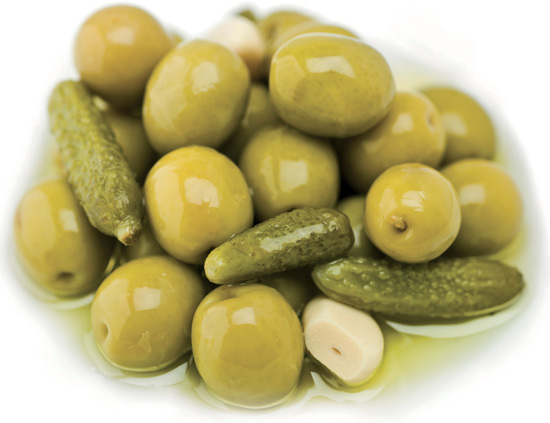Preserved delicacies in attractive jars make unique and tasty gifts.
Fruits, vegetables and herbs are easy to preserve in vinegar or oil—as people have done for centuries. It puts homegrown produce to good use, produces delicious food and gives bacteria little chance of thriving.
Select vinegars and oils carefully, as they will influence the taste of the finished product. And remember that cleanliness plays an important role in any method of preserving food.
• Choose mild, refined oils such as olive, sunflower, grapeseed and corn oil; they won’t overpower the flavor of the ingredients.
• Add some herbs or spices for a stronger taste when pickling or preserving foods.
• Pick light, distilled varieties of vinegar with good flavor, such as cider, white wine or white malt.
• Practically anything with a reasonably firm peel can be pickled. Fruit such as pears and plums, or mixtures of vegetables and fruit taste wonderful in a sweet-sour mixture of ingredients.
• Never use dishes made of aluminium or copper when pickling. The acid in the vinegar will attack the surface and there is a risk that the pickles will become contaminated.
• Before consuming the fruits of your labor, let the pickles or preserves steep for at least a month. After opening, keep jars in the fridge.
Use this basic recipe to pickle vegetables.
1 To keep vegetables crisp and prevent them from diluting the vinegar with their high water content, place them first in a salt brine for around 24 hours. Mix together 1 quart (1 L) water and about 1/4 cup (55 g) salt, put the vegetables into a bowl and cover with the brine. Rinse them thoroughly before use.
2 For the vinegar solution, boil about 2 cups (500 ml) vinegar and 1 cup (250 ml) water, 1 teaspoon (5 ml) salt, plus any spices and herbs.
3 Briefly blanch about 2 pounds (1 kg) washed and sliced vegetables in the solution.
4 Remove them with a skimmer or slotted spoon and layer in a jar to within 1 inch (2.5 cm) of the rim.
5 Layer fresh spices between the vegetables. Commonly used spices include peppercorns, bay leaf, mustard seeds, whole garlic cloves and chile flakes.
6 Rather than adding spices directly to the jars, you can also suspend them in the pickling liquid wrapped in a square of muslin tied with string. Remove before filling the jars.
7 Boil the vinegar solution again and pour it into the jars. The liquid should cover the vegetables completely. Seal the jars and label them with the date and a description of the contents.
GOOD TO KNOW 
Pricking pickled foods
Cucumbers and plums turn out spicier and crispier if you prick them all over with a toothpick before preserving them.
• Add 2–3 teaspoons (10–15 ml) sugar to the sour vinegar solution, according to taste, then follow the same method as with sour pickling.
• Stone fruit such as plums can be layered in the jars raw, ideally halved and pitted. Fill up the jar with the hot vinegar solution and seal.
• Good spices for sweet–sour pickling include cloves, ginger, star anise and allspice.
• Honey or fruit juice concentrate can replace some of the sugar.
• Sweet–sour fruits pickled in vinegar go well with meat dishes.
• Oil provides an airtight seal for the ingredients, thus improving their shelf life. Depending on the recipe (fruit and vegetables are the best ingredients to choose), additional preserving through salting, cooking or marinating in oil may be necessary.
• If you want to preserve 2 pounds (1 kg) vegetables, you need 2 cups (500 ml) oil, 1 tablespoon (15 ml) salt, and spices and herbs according to taste.
• After washing and rinsing the produce, cut it into bite-size pieces and steam it briefly. Cool before using.
• Dry tomatoes in advance in the oven. Lightly brown eggplant or sweet peppers under the grill. They don’t need to be steamed.
• Layer the vegetables in the jars with spices and herbs and pour in enough oil—heated to about 165°F (75°C)—to cover them.
• Press down firmly with a spoon so that all air bubbles rise and the jars can be sealed airtight.
• You can vary the flavorings: Green peppercorns, thyme and lemon peel go well with mushrooms; tomatoes taste especially delicious when seasoned with basil, mint, rosemary and chile; eggplant goes well with garlic and lemon.
• As seasonings and herbs release their flavoring into the oil, it can be used for seasoning other dishes and for making marinades and salad dressings.
OIL PROVIDES an airtight seal for THE INGREDIENTS.
